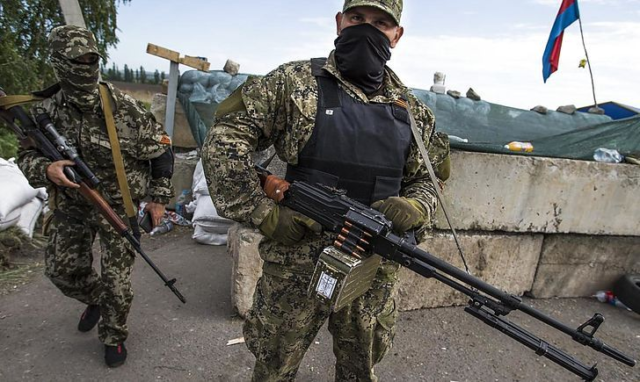
New Ukraine Ceasefire Agreement Officializes Donetsk-Luhansk Militaries (Part One)
Publication: Eurasia Daily Monitor Volume: 17 Issue: 111
By:

Moscow has maneuvered Ukraine’s Presidential Office into quasi-recognizing Russia’s military proxies in “certain areas of the Donetsk and Luhansk regions” (Russian and Ukrainian acronym: ORDLO) for the first time. The vehicle for this breakthrough is the agreement on “Measures to Strengthen the Ceasefire Regime,” negotiated in the Minsk Contact Group, released on July 22, and effective from July 27 for an unlimited duration (President.gov.ua, July 22, 28).
Russia, Ukraine, the Organization for Security and Cooperation in Europe (OSCE), and ORDLO representatives from Donetsk and Luhansk worked out this document in the Minsk Contact Group format. The document officializes the “ORDLO armed formations” as constituting parties to the agreed measures, on an equal footing with the Ukrainian Armed Forces. It sets up procedures for the Ukrainian forces and those of ORDLO (“the sides”) to interact with each other in upholding the ceasefire—a process that would, over time, cement the quasi-recognition of Donetsk-Luhansk forces. The document makes these forces appear as a free agent, thus covering up their integration with and subordination to Russia’s military. This agreement turns a blind eye to Russia, leaving it free of responsibility for possible ceasefire violations by its proxies (and indeed for employing proxy forces). The whole arrangement plays to Moscow’s definition of this war as internal to Ukraine, implicitly undermining the case that Russia is actually involved in a state-on-state war in Ukraine.
The document, as released by the OSCE’s chairmanship (Osce.org, July 23), is valid “for the whole period until full comprehensive settlement of the conflict.” Its content is almost entirely of a military nature, aiming for a full de-escalation of the positional warfare. Toward that aim, it imposes bans on sniper fire, the use of any types of unmanned aerial vehicles, and the deployment of heavy weapons in and near inhabited localities; moreover, it precludes any offensive, reconnaissance in force, and sabotage operations. In addition, it envisages effective (though unspecified) disciplinary actions for ceasefire violations (implying though not stating outright that either side would discipline its own personnel). All of these measures are intended to be applied along the entire demarcation line. These measures supplement the pullbacks of heavy weaponry from the demarcation lines following the 2015 armistice and subsequent disengagement measures in selective sectors.
These military measures, however, come with their built-in political-diplomatic ramifications, to Ukraine’s disadvantage.
The “sides” envisage creating and activating a “coordination mechanism for responding to ceasefire violations, through the facilitation of the Joint Center for Control and Coordination (JCCC) in its currently operating composition” or “currently active membership” (“v deystvuyushchem sostave”). This joint entity would be empowered to allow the top military command of either side (Ukrainian or ORDLO forces) to open fire in response to “offensive actions” by the other side.
The reference to the JCCC’s composition (membership) is not further explained. The JCCC used to be a ceasefire-monitoring military entity of Russian and Ukrainian officers, with ORDLO representatives in Russia’s tow as observers. It operated from 2014 until December 2017, at which point Russia withdrew from the JCCC, aiming to turn it into a Ukraine-ORDLO military entity. This was (and is) meant to signify de facto recognition of ORDLO forces by Ukraine, to depict the conflict as internal to Ukraine, and to make these two “sides” jointly monitor “their” ceasefire, as if Russia were not a party to the conflict. Ukraine, therefore, never accepted the ORDLO in the JCCC. Nor did Ukraine ever quit the JCCC: it still exists theoretically but is not operational as a joint entity.
For their part, the Donetsk and Luhansk “people’s republics” (DPR, LPR) each operate a “representation to the JCCC,” with a dedicated media outlet (Dnr-sckk.ru). They advance the obviously false claim that the JCCC “currently consists of representatives of the Ukrainian, DPR and LPR forces” (Dnr-sckk.ru, accessed July 28). The agreement just concluded in the Minsk Contact Group also references the JCCC’s “current composition/membership,” without elaborating (see above). There may well be some overlap to these versions, particularly since the ORDLO delegations in Minsk were parties to negotiating the agreement just concluded (see above).
Ever since Russia discontinued the original JCCC, officers from Donetsk and Luhansk forces impersonate it in ORDLO territory. They wear JCCC insignia, claim to perform JCCC-like ceasefire observation on behalf of Donetsk and Luhansk, but also control the movement of the OSCE’s monitors. These and the Ukrainian side often have no choice but to deal with the Donetsk and Luhansk “JCCC” personnel on the ground regarding access to ORDLO territory and various inevitable transactions across the demarcation line. The Donetsk-Luhansk “JCCCs” profess to be eager to cooperate with “all sides involved in the JCCC.”
For its part, Kyiv is trying to bring Moscow back into the JCCC. Unlike former president Petro Poroshenko’s attempts to include the “Normandy” powers Germany and France in the JCCC, the Volodymyr Zelenskyy presidency turned to Russia when the new president’s office took over the negotiations. Ukraine’s delegation to the Minsk Contact Group invited Russia back into the JCCC in September 2019, a move applauded by the Kremlin’s Ukrainian protagonist Viktor Medvedchuk (112.Ukraine, September 5, 2019). Zelenskyy repeated this invitation when meeting Russian President Vladimir Putin at the Normandy summit on December 9, 2019, in Paris, according to the Ukrainian government’s top official in charge of these matters, Oleksiy Reznikov (Hromadske, July 27, 2020).
Following the publication of the ceasefire-strengthening measures just agreed in Minsk, Reznikov went beyond the agreed text (see above) and hoped aloud that Russia’s officers would rejoin the JCCC. Reznikov’s argument: “Based on the experience of other conflicts, such a mechanism is effective […] this would allow us to move toward de-escalation and a permanent ceasefire regime” (Hromadske, Interfax-Ukraine, July 27). Apart from Ukraine (until 2017), it is Georgia and Moldova that could share their experience with ceasefire-monitoring bodies structured similarly to the JCCC.



